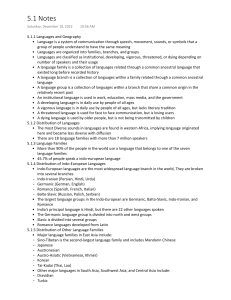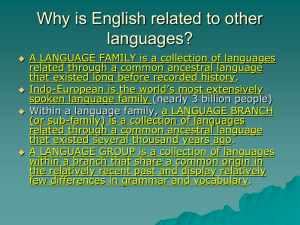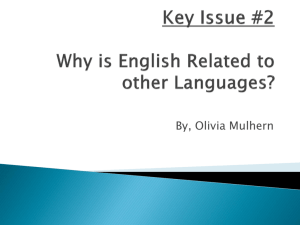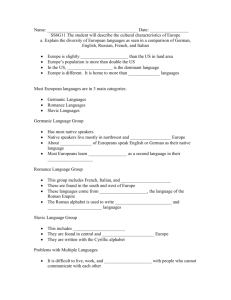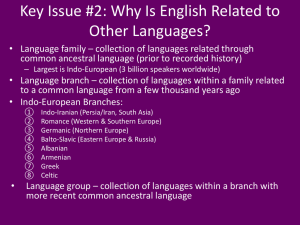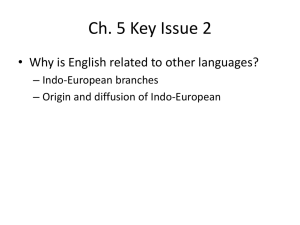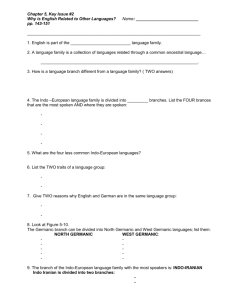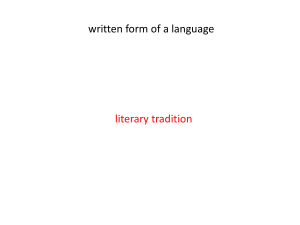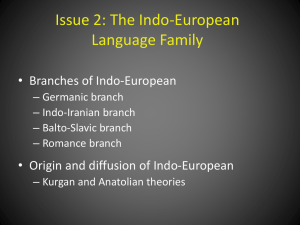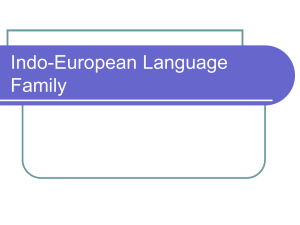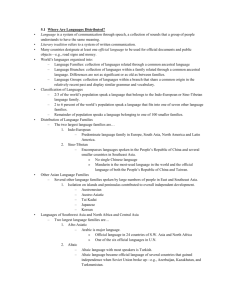File - Mrs. Goldstein's Class
advertisement
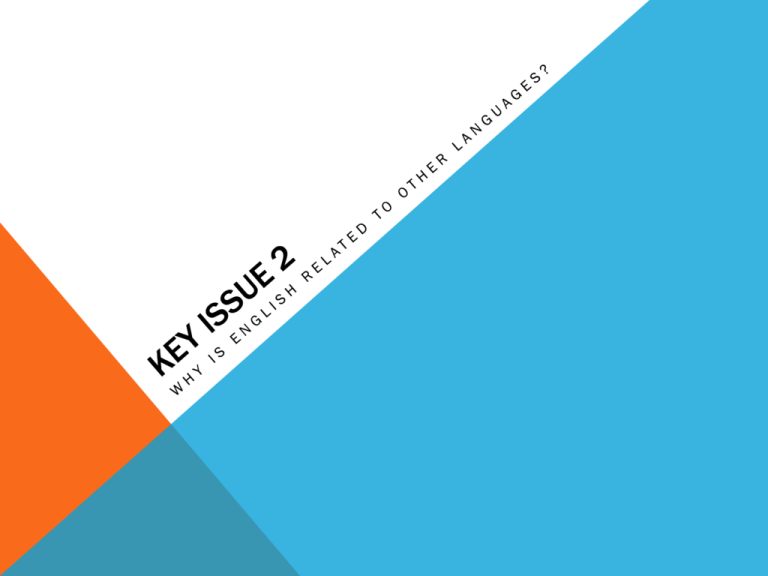
INDO-EUROPEAN BRANCHES English is part of the Indo-European language family Most extensively spoken language family, spoken by 48% of people Nearly 3 billion people speak an IndoEuropean language as their 1st language INDO EUROPEAN BRANCHES Language Branch: collection of languages related through a common ancestral language that existed thousands of years ago Divided into 8 branches Most spoken: Indo-Iranian, Romance, Germanic and Balto Slavic Least spoken: Albanian, Armenian, Greek & Celtic INDO-EUROPEAN LANGUAGE FAMILY Fig. 5-5: The main branches of the Indo-European language family include Germanic, Romance, Balto-Slavic, and Indo-Iranian. USING COLORED PENCILS, COLOR-CODE YOUR MAP Indo-European Language Branches Albanian Germanic Armenian Greek Balto-Slavic Indo-Iranian Celtic Romance ON THE BACK OF YOUR MAP Divide your paper into 8 parts for each of the language branches -take notes for each branch using Key Issue 2: Figure 5-5, 5-8, 5-12 More-Spoken Branches Less-Spoken Branches Indo-Iranian Albanian Germanic Armenian Romance Greek Balto-Slavic Celtic GERMANIC BRANCH English & German are closely related -Germanic tribes that invaded England 1,500 years ago -Other Germanic languages: -Dutch & Frisian (Netherlands) -Flemish (Belgium) -Afrikaans (South Africa) -Scandinavia: Swedish, Danish, Norwegian, Icelandic GERMANIC BRANCH OF INDO-EUROPEAN Fig. 5-6: The Germanic branch today is divided into North and West Germanic groups. English is in the West Germanic group. INDO-IRANIAN BRANCH Most spoken of Indo-European family More than 100 languages, 1 billion people Eastern Group: Indic Western Group: Iranian INDIC (EASTERN) GROUP OF INDO-IRANIAN BRANCH 2nd largest language group Mostly common in India 1/3 of Indians speak Hindi (Indic) -Many ways to speak it -Only ONE way to write it: Devanagari (7th Century) -Until recently few speakers could read/write it Pakistan: Urdu language -spoken like Hindi, but written in Arabic (Muslim) INDIA 4 language families represented in India -IndoEuropean (North) -Dravidian (south) -Tibetan (NE) -Austro-Asiatic (central/Eastern highlands) Independence, 1947 Proposed official language: Hindi Dravidian speakers of South objected Constitution recognizes 18 official languages English is often used for communication as a “common language” SOUTH ASIAN LANGUAGES AND LANGUAGE FAMILIES Fig. 5-7: Indo-European is the largest of four main language families in South Asia. The country of India has 18 official languages. IRANIAN (WESTERN) GROUP OF INDO-IRANIAN BRANCH Iran & southwestern Asia Persian (Farsi): Iran Pashto: E Afghanistan & W Pakistan Kurdish: W Iran, N Iraq, E Turkey All written in Arabic alphabet BALTO-SLAVIC BRANCH OF INDO-EUROPEAN Formerly a single language 7th Century AD, Slavs migrated from Asia to E Europe Different languages as a result of migration Four major groups: East, West, South Slavic and Baltic EAST SLAVIC AND BALTIC GROUPS Most widely spoken: Russian, 80% of Russian people Soviet officials forced native speakers of other languages to speak Russian Form a sense of national unity After collapse of Soviet Union, eastern countries adopted other official languages -shows more cultural diversity Russian still used for communication in countries formerly part of Soviet Union Ukranian & Belarusan: 2 other important languages in East Slavic languages WEST AND SOUTH SLAVIC GROUPS Polish: most spoken West Slavic language Former Czechoslovakia Czech and Slovak: understand each other's languages -tried to balance the two languages (1/2 sport game announcement in each) -Slovakia split from Czech Republic in 1993 Former Yugoslavia: language was Serbo-Croatian Two alphabets: Roman alphabet & Cyrillic alphabet Now: Bosnian, Croatian, and Serbian: all very similar Suppressing Nationalism in Yugoslavia ROMANCE BRANCH OF INDO-EUROPEAN Evolved from Latin: spoken by Romans 2000 years ago Four most spoken: Spanish, Portuguese, French and Italian Mountains separate the countries: intervening obstacles -barriers to communication Romanian: 5th most spoken: Romania & Moldova Other languages: 1) Romansh (Switzerland) and 2) Catalan (Andorra-Pyrenees and E Spain-Barcelona) 3) Sardinian mixture of Spanish, Arabic & Italian (Sardinia) SPANISH VS CATALAN Castillian Spanish Latin American Spanish English billete (m) boleto (m) ticket ordenador (m) computadora (f) computer tortilla (f) tortilla (f) In Spain, a ‘tortilla’ is an omelette. In Latin America, a ‘tortilla’ is a flat bread. melocotón (m) durazno (m) peach patata (f) papa (f) potato ORIGIN OF DIFFUSION OF ROMANCE LANGUAGES Diffusion of Latin language during expansion of -Roman Empire over hundreds of years Previous languages spoken mostly eliminated Latin varied throughout empire Merged & evolved with previous languages ORIGIN AND DIFFUSION OF ROMANCE LANGUAGES “Vulgar Latin” a spoken form of Latin, used throughout the Roman Empire Literary term: equus - equestrian, equine Vulgar term: caballus caballo, cavalo, cheval Collapse of Roman Empire, 5th Century Communication between provinces decreased -creating more variation in languages ROMANCE LANGUAGE DIALECTS Francien French Language of Paris (capital/largest city), dominated local dialects Became official language for France in 16 th Century North and South Dialects derive from different ways to say “yes” in Latin Yes Latin Hoc illud est Northern France Langue d’oil Paris o – il “wheel” “oui” Southern France Langue d’oc oc ROMANCE LANGUAGE DIALECTS Spain Castilian, 9th century in Old Castile, North-central Spain Spread southward 15th Century, Spain united into present country Castilian became official language Regional dialects only remained in secluded rural areas “Castilian” or “Spanish” is official language of Spain today SPANISH & PORTUGUESE 90% of speakers live outside Europe Diffused to America by Spanish & Portuguese Land divided by Pope Alexander VI 1493 Spanish Royal Academy Meet weekly to clarify spelling, vocab, pronunciation of “Spanish” PORTUGUESE 1994 language was standardized Language more closely resembles Brazilian Portuguese Upsets people in Portugal Eliminates accent marks CREOLE LANGUAGES Distinction between a dialect and a new language can be difficult Speakers like to classify their dialect as a distinct language Creolized languages (origin of “creole” = slave born in master’s house) A language that results from mixing of colonizer’s language with the indigenous language of people being dominated French Creole in Haiti Portuguese Creole in Cape Verde islands of African coast ORIGIN AND DIFFUSION OF INDO-EUROPEAN Germanic, Romance, Balto Slavic and IndoIranian languages Same language family: Indo-European Evidence of a single ancestor cannot be proved with certainty KURGAN THEORY OF INDO-EUROPEAN ORIGIN Fig. 5-9: In the Kurgan theory, Proto-Indo-European diffused from the Kurgan hearth north of the Caspian Sea, beginning about 7,000 years ago. ANATOLIAN HEARTH THEORY OF INDOEUROPEAN ORIGIN Fig. 5-10: In the Anatolian hearth theory, Indo-European originated in Turkey before the Kurgans and diffused through agricultural expansion.
